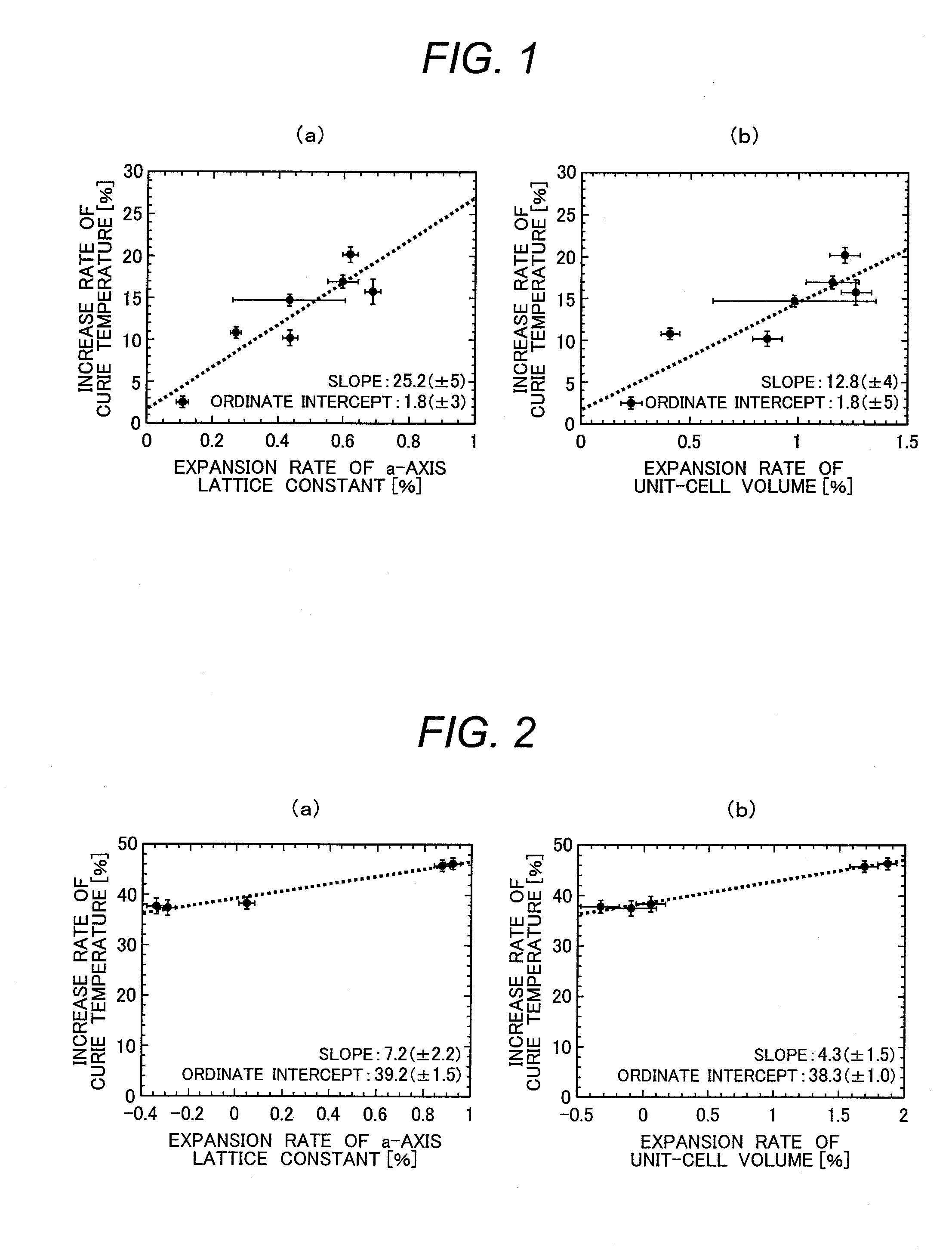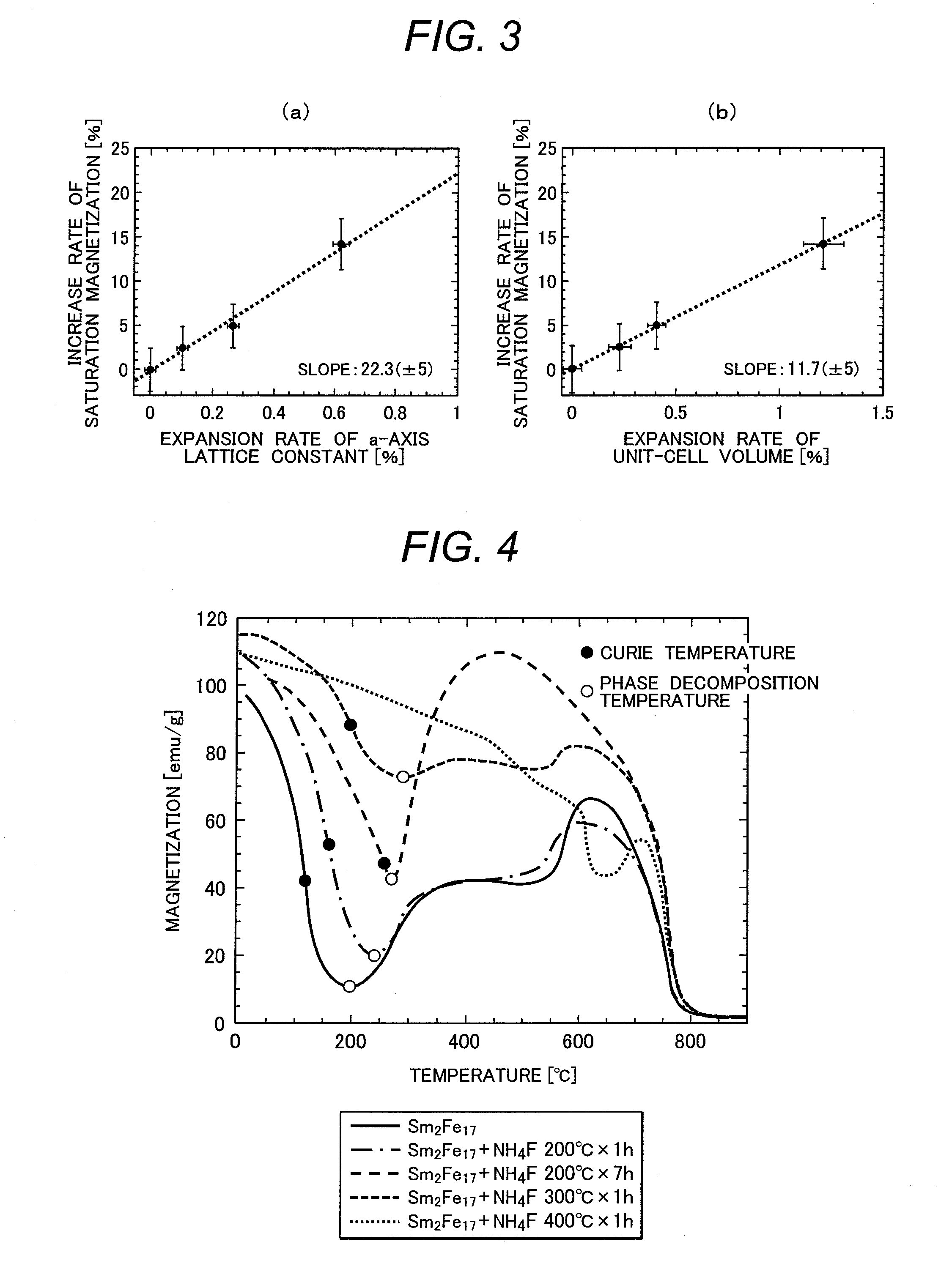Ferromagnetic compound magnet
a compound magnet and magnet technology, applied in the field of permanent magnets, to achieve the effect of improving the magnetic anisotropy, improving the magnetic properties of a main phase, and increasing the magnetization
- Summary
- Abstract
- Description
- Claims
- Application Information
AI Technical Summary
Benefits of technology
Problems solved by technology
Method used
Image
Examples
first embodiment
of the Invention
[0061]The present invention provides a magnetic material whose magnetic properties have been improved by the incorporation of the element F. In the present embodiment, a fluorination method will be discussed; but off course, fluorination can be combined with at least one of the already-known methods of hydrogenation, nitrogenization, and carbonization. It is also possible to fluorinate a parent phase which has been hydrogenated, nitrogenized or carbonized, or vice versa.
[0062]The incorporation of F into a crystal lattice of the alloy causes the p-state of the electron orbital to appear in the low energy side, making the covalent status with Fe in the crystal lattice weaker. Consequently, the volume of the crystal lattice is increased to create a geometric effect that drastically increases the magnetic moment and raises the Curie temperature. Furthermore, characteristically, an electric-field gradient at the R position in the crystal lattice is significantly changed b...
second embodiment
of the Invention
[0073]In the present embodiment, characteristics of the ferromagnetic fluorine compound powders prepared above will be described. FIG. 1 is graphs showing: (a) a relationship between increase rate of Curie temperature of Sm2Fe17Fx and expansion rate of a-axis lattice constant thereof; and (b) a relationship between increase rate of Curie temperature of Sm2Fe17Fx and expansion rate of unit-cell volume thereof. Note that the Curie temperature is defined as a polarized point in the temperature dependency curve of magnetization in a magnetic field of 0.5 tesla (T); the crystal lattice constant and the unit-cell volume are values at 20° C. As shown in FIG. 1(a), the Curie temperature increases with expanding the a-axis lattice constant, and has a slope of 25.2 (±5). Its ordinate intercept is 1.8 (±3). As shown in FIG. 1(b), the Curie temperature increases with expanding the unit-cell volume, and has a slope of 12.8 (±4). Its ordinate intercept is 1.8 (±5). Similar trends ...
third embodiment
of the Invention
[0091]In the present embodiment, temperatures for the fluorinating heat treatment will be described. Appropriate temperatures for the fluorinating heat treatment can be estimated to some extent from DSC (differential scanning calorimetry) characteristics. FIG. 13 shows results of DSC measurements of Sm2Fe17 in: (a) Ar atmosphere; and (b) N2 atmosphere. The figure shows two distinctive exothermic reactions in both Ar and N2 atmospheres. Since the second exothermic reaction was large and kept on at high temperatures in the N2 atmosphere, it is assumed to be corresponding to the reaction of the intrusion of the N atoms into a Sm2Fe17 crystal lattice. In the first embodiment, the fluorinating heat treatment exhibited good characteristics until 300° C., but at a fluorinating heat-treatment temperature of 400° C., almost no Sm2Fe17 structure was observed. For this reason, the heat-treatment temperature for fluorination is preferably lower than 400° C., and more preferably,...
PUM
| Property | Measurement | Unit |
|---|---|---|
| Curie temperature | aaaaa | aaaaa |
| Curie temperature | aaaaa | aaaaa |
| magnetic field | aaaaa | aaaaa |
Abstract
Description
Claims
Application Information
 Login to View More
Login to View More - R&D
- Intellectual Property
- Life Sciences
- Materials
- Tech Scout
- Unparalleled Data Quality
- Higher Quality Content
- 60% Fewer Hallucinations
Browse by: Latest US Patents, China's latest patents, Technical Efficacy Thesaurus, Application Domain, Technology Topic, Popular Technical Reports.
© 2025 PatSnap. All rights reserved.Legal|Privacy policy|Modern Slavery Act Transparency Statement|Sitemap|About US| Contact US: help@patsnap.com



